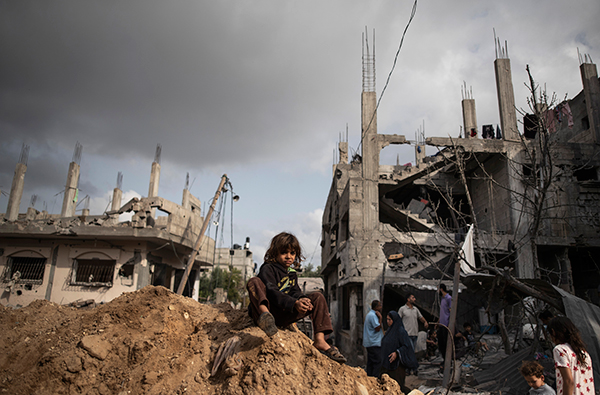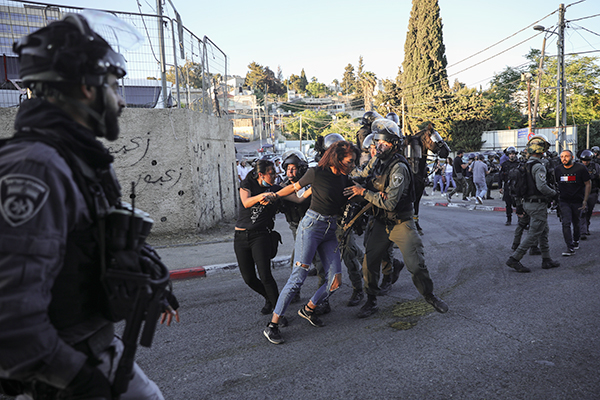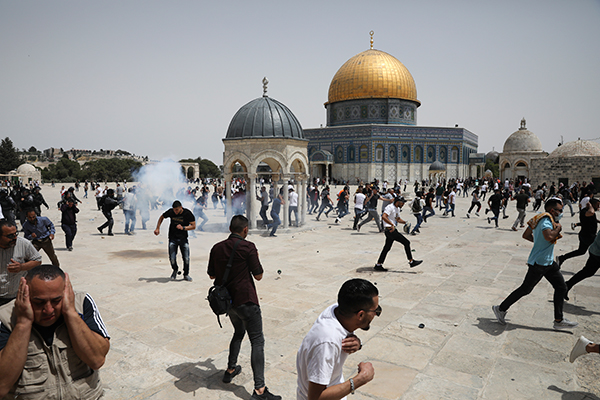What Israel’s Prime Minister Netanyahu Calls an “Exceptional Success”
| revcom.us
Life in Gaza Goes from Unbearable Crisis to Catastrophe
Life in Gaza was unbearable before Israel began a massacre from the skies on May 10. Now life is much worse. What were crises in health care, access to water and electricity, schools, housing, and life for women have become catastrophes.
Death: As bodies are pulled out of the rubble left behind by Israeli missiles and bombs, the death toll in Gaza stands at 248 and counting, including 66 children.
Homes: Seventy-five thousand people began leaving United Nations schools where they had sought refuge from bombs that targeted densely populated neighborhoods and slaughtered whole families in their homes. Clutching blankets and a few possessions, many found the homes they left behind were no longer there. Nazmi Dahdouh, 70, a father of five, said his house in Gaza City was destroyed in an Israeli attack. “We don’t have another home. I’ll live in a tent on top of the rubble of my home until it’s rebuilt,” he told the AFP news agency.
Officials in Gaza said that as many as 2,000 homes and apartments were destroyed, resulting in 80,000 people who had been living in packed-together conditions losing their homes or having their homes seriously or partially damaged.

Palestinians return to homes that were destroyed by Israeli airstrikes in Beit Hanoun, Gaza, May 21. Photo: AP
Health care: Israel bombed 17 hospitals and clinics. Those facilities are now trying to treat almost 2,000 people injured by bombs and missiles.
Israeli bombs knocked Gaza’s only coronavirus test laboratory out of commission. COVID-19 vaccinations have been canceled and doctors’ appointments were postponed. In a particularly obscene outrage, Dr. Ayman Abu al-Ouf, head of internal medicine at Al-Shifa Hospital, was killed when Israeli missiles struck his family’s home in Gaza on May 16. At least 33 people were killed in the attack.
Water and sewage: Israeli bombing damaged Gaza’s sewage system, sending wastewater into its streets. The bombing broke water pipes serving at least 800,000 people, setting off a humanitarian crisis that is touching nearly every civilian in Gaza. (New York Times, May 18, 2021). And as a result of the bombing, a desalination plant that helped provide fresh water to 250,000 people in the territory is off line. On May 18, the United Nations International Children’s Emergency Fund (UNICEF) estimated that 325,000 people needed emergency water and sanitation services, without which they are more likely to contract potentially deadly infectious diseases.
Electricity: Electricity output across Gaza, always intermittent and unreliable, dropped by 60 percent, leaving hospitals increasingly dependent on generators for the provision of essential health care services. These generators require significant amounts of fuel to function. Any reduction in health care capacity could also jeopardize treatment for those with COVID-19.
Schools: Dozens of schools have been damaged or closed, impacting 600,000 students.
Food: Before the latest massacre began, the New York Times reported, “At grocery stores, beggars jostle with middle-class shoppers, who sheepishly ask to put their purchases on credit. The newly destitute scrounge for spoiled produce they can get for little or nothing. ‘We are dead, but we have breath,’ said Zakia Abu Ajwa, 57, who now cooks greens normally fed to donkeys for her three small grandchildren.” Before the bombing, the U.S. was withholding $65 million from the United Nations Relief and Works Agency, which provides services and support for 1.2 million people in Gaza, many of whom rely on its regular handouts of flour, cooking oil, and other staples to survive. The food crisis has been greatly intensified by the bombing.
Women: Israeli bombs hit Umm Majed al-Rayyes’ apartment building in Gaza City on Wednesday, throwing her from her bed. As walls exploded and windows broke, the 50-year-old gathered her four children and tried to find a place to hide. “This whole territory is a tiny place. It’s a prison. Everywhere you go, you’re a target,” al-Rayyes told Voice of America. She said the Israeli airstrike came without warning. In a place with the world’s highest unemployment rate, jobs are much more scarce for women, but even at home, women and children are still over 40 percent of Gazans dead from Israeli bombs and missiles since May 10. And women bear the brunt of dealing with the death, destruction, and trauma of Israeli missiles and bombs on children.
As the world reacts to the devastation in Gaza with heartbreak, shock, horror, and outrage, Israel’s Prime Minister declared Israel’s assault on Gaza to be an “exceptional success.” And that “We achieved our goals in the operation.” In doing so, he gave those with eyes to see and hearts to feel an understanding of what Israel’s real objectives are for the Palestinian people. And why those objectives are utterly illegitimate.
Gaza Is an Open-Air Prison
Israel controls all access in and out of Gaza via air, land, and sea (one small crossing between Gaza and Egypt has been closed by Egypt for almost all of the past 12 years). Israel does not allow operating air and seaports in Gaza in violation of agreements between Israel and the Palestinians. The Gaza airport, funded by donor countries, was destroyed by Israeli bombardments and bulldozers. Gaza has a long coastline on the Mediterranean Sea, but a Gaza seaport project, started in 2000, was destroyed by the Israeli army. Israel attacks fishermen who venture beyond a small Israel-decreed zone and shut down fishing entirely during its recent massacres. What few rights Palestinians in Gaza have to even apply for permission to travel, including to visit close relatives in other parts of Israel-controlled Palestine, require ID cards administered (and often arbitrarily withheld) by Israeli authorities.
Access to education and culture is choked off by Israel. Dozens of schools were damaged or closed by Israeli missile and bomb attacks over the 10-plus days of bombardment in May, impacting tens of thousands of students. Students accepted and offered scholarships at schools in Europe are systematically denied exit visas by Israeli authorities. (See, for example, The Right to Education: Gaza Students Denied Permit to Attend EU-sponsored Summer School in France and A Palestinian Student Wants a Visa to Europe? Let Him Do Research in Gaza.) In the latest massacre, Israeli bombs destroyed the largest bookstore in Gaza that provided people there with exposure to their own literature, and the literature of the outside world.
Life in East Jerusalem and the West Bank: 24-7 Terror for Palestinians
Brutal repression by Israel of protest against eviction of Palestinian families from their homes in East Jerusalem was a spark that set off the wave of Palestinian protest and Israel massacres of the last two weeks. A deputy mayor of Jerusalem justified those evictions as part of placing “layers of Jews” throughout East Jerusalem “to secure the future of Jerusalem as a Jewish capital for the Jewish people.” And that, in turn, is part of a larger picture of generations of genocidal displacement, massacres, terror, and oppression that have amounted to the ethnic cleansing of Palestine that is now reaching genocidal proportions. (For background, see the special resource page at revcom.us and the segment on Israel and Palestine in Episode 53 of the RNL—Revolution, Nothing Less—Show.)

Israeli police attack protesters in the Sheikh Jarrah neighborhood of East Jerusalem, where several Palestinian families are under imminent threat of forcible eviction from their homes, May 15. Photo: AP/Mahmoud Illean
Living Under Constant Threat of Eviction in East Jerusalem
A piece in the May 22 New York Times1 gave a sense of what it means to live as a Palestinian under constant threat of eviction in East Jerusalem. Muhammad Sandouka was at work one day when an Israeli official confronted his wife with two options: tear the house down, or the government would not only level it but also bill the Sandoukas $10,000 for its expenses.
As the Times article accurately notes, “Such is life for Palestinians living under Israel’s occupation: always dreading the knock at the front door.”
The official reason: because razing it would improve views of East Jerusalem for tourists. Another Israeli official told the Times that erasing Mr. Sandouka’s neighborhood was necessary to restore views of the East Jerusalem “as they were in the days of the Bible.”
24-7 Terror in the West Bank
Israeli soldiers impose a 24-7 reign of terror in the West Bank region of Palestine. Badr Abu Alia was awakened around 2 am by the sounds of soldiers breaking into his neighbor’s home in Al Mughrayyir, a village on a ridge in the West Bank. The Times reports what happened next: “When they got to his door, a familiar ritual ensued: His children were rousted from bed. Everyone was herded outside. The soldiers collected IDs, explained nothing and ransacked the house. They left two hours later, taking with them a teenager from next door, blindfolded. He had taken part in a protest four days earlier, when an Israeli sniper shot and killed a teenager who was wandering among the rock-throwers and spent tear-gas canisters.”
Note: this is a “familiar ritual” for Palestinians in the West Bank.
And the terror, destruction, and death from the Israeli army takes place in sync with unofficial terror by Israeli “settlers”—really Ku Klux Klan-style racist terrorists. In Al Mughrayyir, settlers have cut down hundreds of olive trees that provide a vital source of income for residents and are emblematic of the agricultural roots of Palestinian society that the Zionists are hell-bent on tearing up. They also burned a mosque. And in 2019, one of these settlers was accused of fatally shooting a villager in the back and has yet to be tried. (For more on the nature and role of the “settlers” in East Jerusalem and the West Bank, see The Reality of Israeli “Settlements”: Escalating Ethnic Cleansing of Palestine.)
Israeli Military Again Attacks Palestinians Leaving the Al Aqsa Mosque in Jerusalem

Heavily armed Israeli soldiers with live ammunition assault worshippers at the Al Aqsa Mosque in East Jerusalem, May 21.
The ceasefire agreement that, for now, halted Israel’s bomb and missile massacre in Gaza did not signal any letup in Israel’s brutal repression against Palestinians in the West Bank region, in East Jerusalem or of Palestinians who are Israeli citizens.
On May 21, at the same time the ceasefire went into effect, Israeli security forces viciously attacked Palestinians leaving services at the Al Aqsa Mosque in East Jerusalem. Israeli security forces fired stun grenades and rubber bullets against thousands of Palestinians leaving the mosque after Friday prayers, injuring 20 people.
CNN reported that the attack was a response to people leaving services shouting slogans in solidarity with Gaza, and in solidarity with Palestinian residents of the East Jerusalem neighborhood of Sheikh Jarrah, where Palestinian families are facing eviction. The attack on people at the mosque was similar to an earlier assault on the mosque that was a provoking factor in setting in motion the events that led to Israel’s massacre in Gaza.
Israeli troops targeted journalists including from mainstream U.S. media. A CNN journalist reported that dozens of Israeli officers hit journalists with batons and tried to point rifles at them, calling them “liars” when they showed them their press cards.
Israeli Bombs Destroyed the Samir Mansour Bookshop. It Was a Window to the Outside World in Gaza.
On May 18, Israeli bombing of Gaza resulted in the destruction of Gaza’s largest bookstore, Samir Mansour Bookshop. Those bombs and Israeli missiles are controlled by as sophisticated a targeting system as exists in the world, and Israel constantly brags that its decisions on who and what to bomb are made deliberately and consciously.
In response, Gaza-based author and professor Refaat Alareer tweeted:
Israel burns books: Palestinian tweets are also lamenting Israel’s annihilation of Gaza’s best and biggest bookshop, Samir Mansour Bookshop @samirbookshop. Samir has all sorts of books especially in English and their translations. No more books for Palestinians.
Israel continues to burn and destroy Palestinian education... A war against culture and books says Samir Bookshop @samirbookshop, the largest in Gaza. Israel levelled the bookshop along with tens of small businesses.
As part of isolating and attempting to crush the spirits and souls of the Palestinian people in Gaza, their access to education and arts in the outside world is systematically cut off. In 2020, Israel banned Mohammed Assaf, the winner of the 2013 Arab Idol TV show contest (the Arab version of American Idol), from entering Gaza to perform. A member of the Israeli Parliament from Prime Minister Netanyahu’s reactionary Likud (Hebrew for “National Liberation”) party said the ban came “after the disclosure of video clips, calling for a struggle against Israel.” (See Israel bans Palestinian singer Mohammed Assaf from entering Jerusalem, Gaza.)
Schools administered by the United Nations and students studying at them have been the direct and intended targets of Israeli bombing attacks in previous massacres of Gaza. The 2014 “war” between Hamas and Israel (really a one-sided Israeli massacre) damaged 547 schools, kindergartens, and colleges and after the war, Israel would not permit building supplies to reach Gaza to repair or rebuild them. In Israel’s war on Gaza in 2008-2009, an Israeli bombing attack destroyed a school run by the United Nations Relief and Works Agency in the Jabaliya refugee camp in Gaza City. The school was clearly marked, and the UN had given the Israelis its GPS coordinates to avoid an accidental attack.
And now Israeli bombs have destroyed the Samir Mansour Bookshop, the largest bookstore in Gaza that provided people there with exposure to their own literature, and the literature of the outside world in multiple languages including Arabic, English, and Hebrew.
1. This particular piece in the New York Times was a departure from their normal practice of whiting out or defending Israel’s crimes against the Palestinian people. The editors of the Times make a consistent practice of portraying the relatively tiny number of Israelis injured or killed in clashes between Israel and Palestinians as comparable to the loss of Palestinian lives, even though the numbers of Palestinians killed is vastly greater than the number of Israelis killed. The Times coverage consistently turns reality upside down, excusing massacres of Palestinians as a matter of Israel exercising a “right to defend itself” (and making any criticisms of Israel in terms of “overreaction”), whiting out the reality that Israel is built on and maintained through terrorist ethnic cleansing of Palestine approaching genocidal proportions. To take one of an endless supply of examples: the Times headline on an article about Israel bombing the Gaza offices of the Associated Press and Al Jazeera, the death toll in Gaza (at that time) of 145 people killed in Israeli air strikes and shelling, 40 of them children, read, “Netanyahu vows attacks until Israel’s security is ensured.” [back]
Get a free email subscription to revcom.us:

